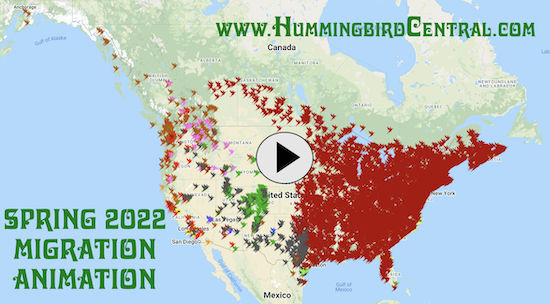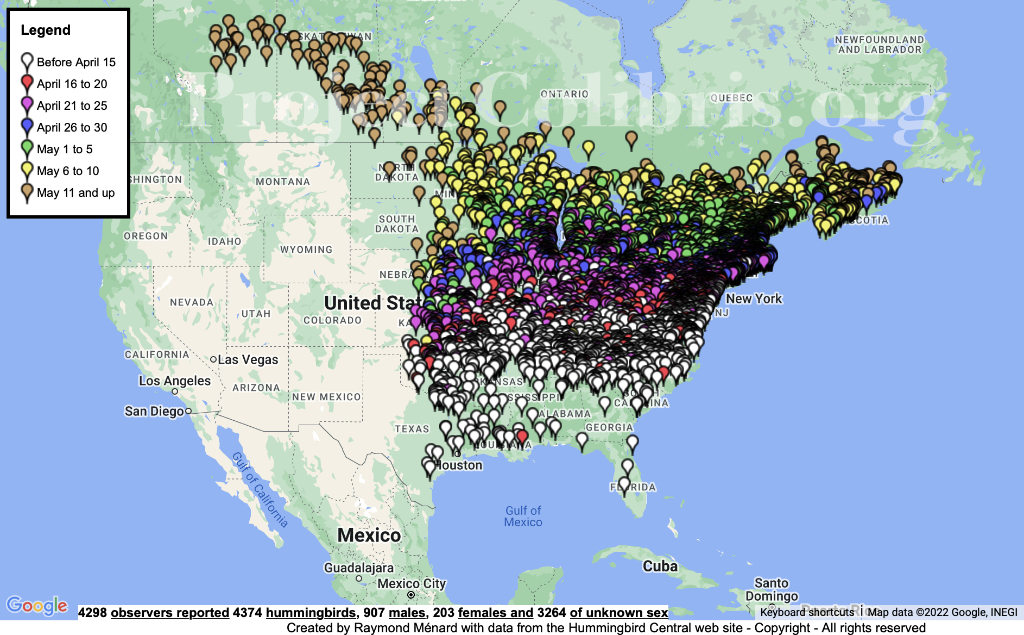Spring 2022 Hummingbird Sightings and Migration Map
The Urge of Migrate
| Interactive 2024 hummingbird migration and sightings map |
| Interactive 2023 hummingbird migration and sightings map |
Many hummingbirds spend the winter in Central America or Mexico, and migrate north to their breeding grounds in the southern United States as early as February, and to areas further north later in the spring.
Hummingbirds fly by day when nectar sources such as flowers are more abundant. Flying low allows the birds to see, and stop at, food supplies along the way. They are also experts at using tail winds to help reach their destination faster and by consuming less energy and body fat.
Research indicates a hummingbird can travel as much as 23 miles in one day. However, during migration as they cross the Gulf of Mexico they may cover up to 500 miles at a time. Their average speed in direct flight is in the range of 20-30mph, and up to three times that fast during courtship dives.
During migration, a hummingbird's heart beats up to 1,260 times a minute, and its wings flap 15 to 80 times a second. To support this high energy level, a hummingbird will typically gain 25-40% of their body weight before they start migration in order to make the long trek over land, and water.
The first arrivals in spring are usually males. Some, however, do not migrate, in areas like California and the upper Pacific coast, the southern United States, and some along the southern Atlantic Ocean areas.
Highlights of 2022 Migration Activity
We typically monitor the spring hummingbird migration from mid-January into May of each year, with the help of our viewers as they submit their first hummingbird sightings in their areas.
Here are some points and policies to note about the posting of reports on our migration map:
|
2022 Hummingbird Spring Migration Interactive Map
|
|
|
Map of Final 2022 Ruby-throated Migration Sightings by Date
The map below shows the final Ruby-throated Hummingbird migration map for 2022, color-coded by date. The map was prepared by the staff at ProjetColibris.org in Quebec. Click on the map below to access an interactive version of the 2022 map, plus previous years of migration data.
Be sure to visit ProjetColibris.org for details of the spring migration in Quebec.
More About the Spring Hummingbird Migration
During migration, a hummingbird's heart beats up to 1,260 times a minute, and its wings flap 15 to 80 times a second. To support this high energy level, a hummingbird will typically gain 25-40% of their body weight before they start migration in order to make the long trek over land, and water. They fly alone, often on the same path they have flown earlier in their life. Young hummingbirds must navigate without parental guidance.
Hummingbirds fly by day when nectar sources such as flowers are more abundant. Flying low allows the birds to see, and stop at, food supplies along the way. They are also experts at using tail winds to help reach their destination faster and by consuming less energy and body fat. Research indicates a hummingbird can travel as much as 23 miles in one day.
Strong cold fronts moving south over the Gulf of Mexico make flying difficult as the birds deal with headwinds and heavy rain, over long distances with no shelter. Food is non-existent over the open waters.
Read more details about hummingbird migration
The Fall Hummingbird Migration
By August and September, hummingbirds are moving south, refueling their bodies in the early morning, traveling midday, and foraging again in the late afternoon to maintain their body weight.
Ruby-throats gather in Florida, Louisiana and along the South Texas coast in September in preparation for the final push to the south, either over the Gulf or via an overland route through Mexico. The Rufous hummingbirds head south, most via the eastern range of the Rocky Mountains. Read more about the fall migration of hummingbirds


